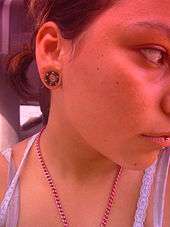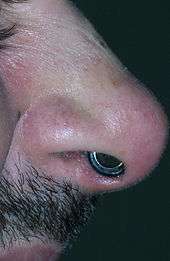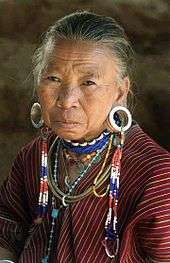Stretching (body piercing)
Stretching, in the context of body piercing, is the deliberate expansion of a healed piercing for the purpose of wearing certain types of jewelry. Ear piercings are the most commonly stretched piercings,[1] with nasal septum piercings, tongue piercings and lip piercings/lip plates following close behind.[2] While all piercings can be stretched to some degree, cartilage piercings are usually more difficult to stretch and more likely to form hypertrophic scars if stretched quickly. Dermal punching is generally the preferred method for accommodating larger jewelry in cartilage piercings.[3]
Stretching is usually done in small increments to minimize the potential for damaging the healed fistula or creating scar tissue. In North America, most stretching methods go up by a single even-sized gauge increment at a time. 00g, or 10 mm, is considered "the point of no return" where anything 10 mm and up will not close to a standard piercing size, while 9 and under will. In Europe and most of the rest of the world, jewelry is metric, but the increments between standard sizes are similar. See the article: Body jewelry sizes.
Health issues
There are few health issues directly related to stretching piercings. Most stretching methods do not create a wound, unless done too quickly. If an individual's skin elasticity and vascularity allow, most piercings can be stretched far beyond their initial size. Anywhere Above 00g or 10mm is normally given as the "point of no return" for earlobe piercings, as over this size there is a significant risk that the hole will never shrink back to the size of the original piercing. Many variables affect whether or not a stretched piercing will return to its original size, such as the length of time taken to stretch and the amount of time the piercing is fully healed at a particular size. However, everyone's ears are unique to themselves as some ears will not heal back from a 2g while some will heal from a 00g. To help with this process, rubbing vitamin E oil on the stretched ears will help keep them open as well as healthy to the point of pushing the point of no return further than the normal time frame.
Jewelry for stretched piercings

There is a large variety of jewelry available for stretched piercings. Many jewelry materials can be used in the manufacturing of jewelry for stretched piercings; materials that would ordinarily be too delicate or brittle to be inserted in smaller-gauge piercings are freely used. Stone, fossilized materials, wood, bone, horn, amber, bamboo, silicone, and glass are not uncommon in stretched piercings. Some of these materials "breathe" better than metals or plastics, preventing the buildup of sebum in the enlarged ear lobe. Jewelry, however, is still often made of acrylic or metal. There are dangers associated with wearing porous materials such as acrylic, stone, wood, bamboo, horn, bone, or other materials with small or microscopic holes, in a freshly stretched piercing. These materials not only have microscopic holes that will trap bacteria and can cause infection, but also cannot be autoclaved or properly sanitized, and are therefore unfit for a fresh stretch or piercing. The best materials for a fresh stretch that is not vulnerable to bacteria are implant grade steel, titanium, and glass. This is because these materials are non-porous and can withstand the heat and pressure of an autoclave, so that they can be properly sanitized before insertion.
The typical jewelry worn in a large stretched piercing is a plug, sometimes incorrectly referred to as a "gauge", which refers to the sizing system used in the U.S. It is solid and usually cylindrical, and may be flared out at one or both ends (saddle-shaped), or kept in place by o-rings fastened around the ends. A variation on this is the flesh tunnel, which is shaped in the same way, but hollow in the middle. Claw-, talon-, and spiral-shaped pieces are also commonplace. Ear-weights in varying degrees of size are also worn, commonly made from silver or bronze, though other metals such as copper or brass are occasionally used. However, some people are easily irritated by some metals; therefore, care should be taken when metal jewelry is worn. Ear cuffs (such as the gold ones utilized in South India provinces) or wrapped bead work (common amongst the Maasai of East Africa) are other options, though are not usually seen in modern Western contexts.
There are several common methods used to enlarge piercings, of various origins and appropriate for different circumstances.
- Tapering: Tapering involves the use of a taper, a conical rod usually made specifically for this purpose. It is lubricated and pushed through the fistula until the widest part of the taper is level with the skin surrounding the piercing. Larger jewelry is then pushed through, parallel to the back of the taper.[3] Tapers come in a variety of sizes and are usually identified by the gauge of the large end. They can vary in length, but most tapers are about 2–3 inches (5.1–7.6 cm) long. Most tapers are made of stainless steel or acrylic and some have threads extending from the wide end to allow the attachment of barbell jewelry, to make insertion easier. Improvised objects like knitting needles and porcupine quills or cocktail sticks are sometimes used as tapers by people stretching at home; however, this is not recommended by professionals, as their gauge cannot be exactly determined and sterile practices are rarely followed at home. Tapering is discouraged at sizes above 2g (6.5 millimeters (0.26 in)).[4] The use of a taper makes it easier to stretch a piercing before it is ready, which can lead to tearing the fistula, pain, bleeding, swelling, blowouts, and scar tissue.
- Dead stretching: Dead stretching is the process of inserting a larger piece of jewelry into an existing piercing without any other equipment.[3] As with tapering, this can lead to injury if the fistula is unready: either a tear of the skin, or a "blowout", in which the fistula is pushed out through the back of the piercing.[5] Some piercings will stretch slightly on their own and larger jewelry can be inserted without the potential for unpleasant side effects, especially piercings that see a lot of "play", such as tongue piercings. Self stretching can be induced in other piercings by massaging the tissue, playing with the jewelry, and tugging it in small circles. Dead stretching is very safe if the lubricated jewelry slides easily into the piercing. The jewelry should never be forced in place.

- Teflon tape stretching: The existing jewelry is removed and a thin layer of non-adhesive Teflon tape (PFTE tape), which is inert and safe for piercing use, is wrapped around the jewelry. Non-adhesive bondage tape and heat-shrink tubing are also frequently used.[3] The jewelry is then re-inserted, and as the piercing adapts to the new diameter of jewelry, the process is repeated with increasingly thicker layers of tape.
- Weights: Large, heavy jewelry or weighted objects can be used to stretch piercings. This method is not widely used in modern-day, as it tends to cause piercings to migrate and can, especially in ears, lead to a thinning of tissue that is disfiguring or requires reconstructive surgery. However, it is a method that has been traditionally utilized by various tribes, such as the Dayaks in Borneo, that practice extreme earlobe elongation.[6]
- Scalpelling: Rather than expanding a healed fistula, this method involves extending the size of the piercing by using a scalpel to cut the edge of the fistula, expanding its diameter. It is often used in earlobe piercings. This technique is also often used to alter the placement of a large piercing, combine two existing piercings into one larger one, or achieve a higher-gauge piercing when scar tissue is preventing stretching, or when tissue has thinned too much making stretching too risky.[7][8]
- Scalpel and taper or pierce and taper: After piercing or scalpelling, a large taper can be inserted directly after, allowing skin to instantly be stretched to large diameters; several inches can be achieved. This method is much rarer and can be extremely painful, causing formation of large amounts of scar tissue. Because of this, it is generally discouraged.[3] The use of a dermal punch followed by tapering is also used in this procedure.
- Dermal Punch: A circular razor of the desired diameter is pressed against the skin of the area (typically earlobe or cartilage). The blade is then pushed down upon and twisted by the piercer to "punch" out a small disk of skin. The razor is then pulled out of the skin and the jewelry (usually a non-flared or single-flared Pyrex Glass plug) of the same size is inserted into the hole created by the razor. This is useful for achieving large-gauge cartilage piercings, and often discouraged for soft tissue that can easily be stretched.[9] It is also described as being less painful and less damaging to tissue than using a hypodermic needle of the same gauge.[3]
- Silicone Plugs: These plugs are soft and malleable, allowing a relatively large plug to be inserted into the fistula. Once folded and inserted into the ear, they expand, stretching the earlobe. However, stretching with silicone is often a dangerous decision. It's not recommended to use silicone plugs to stretch, due to the tacky, porous surface. The stretched fistula can adhere to the silicone if the lubricant used is pushed out by the pressure of the stretch, and an airtight seal can be created, trapping infection and causing it to spread internally. Also because silicone expands and contracts in temperature change, they can swell and potentially blow out a newly stretched fistula.[10]
History and culture

Tribes in various countries in Africa, Eurasia, America and other lands have practiced the ritual of ear stretching for cultural, religious and traditional purposes. This is a ritual that has been practiced by people all over the world from ancient times. Bone, horn, wood, and stone were generally carved for ear stretching, but other organic materials that had the right shape naturally, from shells to teeth and claws, were also used.[11][12]
Many young, western people adopted the practice of stretching ear lobes in order to stand out and look different in society. This seems to give the impression that this is a modern practice, although it is not. The practice of stretching ear lobes, as well as tattooing, scarring, branding, and hairstyles has been found to be as old as recorded human history. Historically, the practice has been used for the purpose of tribal status, to scare enemies in war, and beauty purposes.[13] It has been and still is a common practice for both men and women. For men, it has been used historically to indicate the standing members of a specific tribe. The bigger the stretching, the higher the ranking the male had. As for women, ear stretching is more for decorative purposes and also signifies when a girl has reached womanhood. These purposes are still important and used today by many tribes and cultures.
There are many examples of different tribes and cultures that use the art and practice of stretching.
King Tutankhamen
Ancient Egyptian pharaoh King Tutankhamen is of one of the earliest known to have stretched ear lobes. It can clearly be seen in one of his more famous images on his sarcophagus.The instrument used to stretch the pharaoh’s ears is unknown, but there are many possibilities including bamboo or wooden plugs.
The Iceman
Mummified bodies with stretched earlobes have been discovered, including the oldest mummified body discovered to date: Ötzi the Iceman (3300BC).[3] The Iceman was found in the Alps between Austria and Italy. This European mummy had a stretch of somewhere between 7–11 millimeters (0.28–0.43 in) in diameter.
Gautama Buddha
Gautama Buddha, an aristocratic and wealthy prince, had long stretched ears. He wore heavy gold earrings or precious stones as a status symbol, and the weight stretched his ear lobes dramatically. his wealth and discarded his jewelry, his ear lobes were permanently stretched.[14] As a way of remembering Buddha's act of personal self-sacrifice in walking away from his wealth, all succeeding images of Gautama Buddha show his stretched ear lobes without jewellery.
Easter Island heads
Stretched earlobes can be found on the heads of the giant statues on Easter Island, giving them the title ‘Long Ears’. It is said that the original inhabitants of Easter Island carved the heads to depict themselves. When another tribe arrived to the Island, they were given the title ‘Short Ears’. The ‘Long Ears’ would enslave the ‘Short Ears’ until there were more ‘Short Ears’ to overthrow them.[13]
Mursi tribal women
The Mursi is a tribe found in Ethiopia known for their women decorating themselves with wooden plates in both their ears and bottom lip.[15] Around the age of fifteen and a year before her marriage, a young woman has her lip and ears pierced by her mother. She then pushes a wooden peg through each piercing. After the healing process, the pegs are changed and go up in diameter (usually 8–22 cm). Once the desired size is reached, the young woman receives a higher degree of respect than those without piercings.
The Maasai People of Kenya
For thousands of years, both men and women have been stretching their ears although today, more women than men follow the practice. Originally, the piercing was done with a sharpened object such as the point of a knife or a thorn. Heavy jewelry was then placed in the hole to increase the size. The Maasai are known for using materials such as animal bones, wood, stone, and tusks for jewelry.[16]
The African Fulani tribe
The Fulani tribe is from Nigeria and Central Africa. At the age of three years, girls will have their ears pierced but not stretched until they are older. These women will stretch their ears to a smaller diameter, unlike the Mursi and Masai tribes, so that they can wear hoops and large gold domes.[17]
Asian hill tribes
The Lahu tribe from Thailand and the Karen-Padaung from Myanmar are two known Asian tribes that practice ear stretching. They both believe that they should wear as much jewelry as possible because ears are revered as sacred.[18]
Mexican and Central American civilizations
Aztec and Mayan men are traditionally known to have had stretched ears. The Aztecs crafted plugs from gold and silver for the higher-class men whereas the lower class wore materials such as shells, wood, and copper. The same idea can be seen with the Mayans. High-class men wore jade plugs, and the rest of society used bone, stone, and wood.[19]
See also
References
- ↑ "Common body piercing problems". Body Jewellery Shop. Retrieved 14 July 2011.
- ↑ Stirn, Aglaja (5 Apr 2003). "Body piercing: Medical consequences and psychological motivations". The Lancet. 361 (9364): 1205–15. doi:10.1016/s0140-6736(03)12955-8.
- 1 2 3 4 5 6 7 Angel, Elayne (2009). Piercing Bible. Random House Digital, Inc. ISBN 978-1-58091-193-1.
- ↑ "Ear Stretching Guide". Bandaru Organics. Retrieved 27 August 2014.
- ↑ "Ear Stretching Info". Pierced & Modified. Retrieved 15 July 2011.
- ↑ Rowthorn, Chris; Cohen, Muhammad (2008). Borneo. Lonely Planet. p. 34. ISBN 978-1-74059-105-8.
- ↑ "Ear Scalpelling". Holier Than Thou. Retrieved 5 July 2011.
- ↑ DeMello, Margo (2007). Encyclopedia of Body Adornment. ABC-CLIO. p. 234. ISBN 978-0-313-33695-9.
- ↑ Hudson, Karen L. "Body Art Glossary Definition - Dermal Punch". About.com. Retrieved 15 July 2011.
- ↑ "Frequently Asked Questions". Kaos Softwear. Retrieved 15 July 2011.
- ↑ Rosaldo, Renato (28 Oct 2009). "Red Hornbill Earrings: Ilongot Ideas of Self, Beauty, and Health.". Cultural Anthropology. 1:3: 310–316.
- ↑ Hayes-Bohanan, Pamela (2010). James H. Birx., ed. "Prehistoric Cultures.". 21st Century Anthropology: 409–419.
- 1 2 "Ear stretching: Why is lobe 'gauging' growing in popularity?". BBC News. Retrieved 16 January 2014.
- ↑ Gray, Paul; Ridout, Lucy (2002). The Rough Guide to Thailand's Beaches & Islands. Rough Guides. p. 442. ISBN 978-1-85828-829-1.
- ↑ "Lip-plates". Mursi Online. Retrieved 16 January 2014.
- ↑ "The Maasai People". Blackethics.com. Retrieved 16 January 2014.
- ↑ "Fulani Earrings". Africa Facts. Retrieved 16 January 2014.
- ↑ "The Karen People". The Peoples of the World Foundation. Retrieved 16 January 2014.
- ↑ "Status, Symbolism and Spirit of the Mayan Ear Flare". Onetribe. Retrieved 16 January 2014.
External links
| Wikimedia Commons has media related to Stretching (body piercing). |
- BMEzine wiki article on stretching
- How to Stretch Your Ears
- Plughog.com: Lip Stretching Guide
- Ear Stretching Forum
- Ear Stretching Guide
- Ear Stretching Information and Techniques